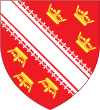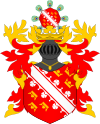Grand Est
Template:Infobox French region Grand Est[1] (French pronunciation: [ɡʁɑ̃.t‿ɛst] ; Template:Lang-en, Template:Lang-de — both in the Alsatian and the Lorraine Franconian dialect —), previously Alsace-Champagne-Ardenne-Lorraine (ACAL or less commonly, ALCA),[2] is a French administrative region in northeastern France. It superseded three former administrative regions—Alsace, Champagne-Ardenne, and Lorraine—on 1 January 2016, as a result of territorial reform which was passed by the French legislature in 2014.[3][4] Alsace-Champagne-Ardenne-Lorraine was a provisional name, created by hyphenating the merged regions in alphabetical order; its regional council had to approve a new name for the region by 1 July 2016.[4] France's Conseil d'État approved Grand Est as the new name of the region on 28 September 2016, effective 30 September 2016.[5] The administrative capital and largest city is Strasbourg.
Toponymy
Provisional name
The provisional name of the region was Alsace-Champagne-Ardenne-Lorraine, which is formed by combining the names of the three present regions—Alsace, Champagne-Ardenne, and Lorraine—in alphabetical order with hyphens. The formula for the provisional name of the region was established by the territorial reform law and applied to all but one of the provisional names for new regions.[4] The ACAL regional council, which was be elected in December 2015, was given the task of choosing a name for the region and submitting it to the Conseil d'État—France's highest authority for administrative law—by 1 July 2016 for approval.[4][6] The provisional name of the region was retired on 30 September 2016, when the new name of the region, Grand Est, takes effect.[5]
In Alsace and in Lorraine, the new region has frequently been called ALCA, for Alsace-Lorraine-Champagne-Ardennes, on the internet.[7]
Like the name Région Hauts-de-France (and, until 2015, the name Région Centre), the name Région Grand Est contains no reference whatsoever to the area's history or identity, but merely describes its geographical location within metropolitan France.
Permanent name
In a poll conducted in November 2014 by France 3 in Champagne-Ardenne, Grand Est (29.16%) and Austrasie (22.65%) were the top two names among 25 candidates and 4,701 votes.[8] Grand Est also topped a poll the following month conducted by L'Est Republicain, receiving 42% of 3,324 votes.[9]
Among the names which have received a moderate amount of discussion are:
- Grand Est is a term used to refer to the northeast quarter of Metropolitan France, although this term refers to a geographic region larger than just ACAL. The term has been commonly used and has topped the polls mentioned above.
- Grand Est Europe (Great East Europe) is a variant of Grand Est that alludes to the region being a gateway to Europe both through trade and since Strasbourg is home to several European institutions (which makes it one of the three unofficial capitals of the European Union).[10] However, the name has been mocked for how it could suggest that the region is in Eastern Europe.[11]
- Austrasie (Austrasia),[8][9] which refers to an historical region spanning parts of present-day northeast France, the Benelux, and northwest Germany.[citation needed]
- Quatre frontières (Four Frontiers), which refers to the region's border with four countries, has also been discussed.[8]
Geography
Grand Est covers 57,433 square kilometres (22,175 sq mi) of land and is the sixth-largest of the regions of France effective 1 January 2016. Grand Est borders four countries—Belgium,[12] Luxembourg,[13] Germany,[14] and Switzerland[15]—along its northern and eastern sides. It is the only French region to border more than two countries. To the west and south, it borders the French regions Nord-Pas-de-Calais-Picardie (provisional name), Île-de-France, and Bourgogne-Franche-Comté (provisional name).

Departments
Grand Est contains ten departments: Ardennes, Aube, Bas-Rhin, Marne, Haute-Marne, Haut-Rhin, Meurthe-et-Moselle, Meuse, Moselle, Vosges.
Topography
The main ranges in the region include the Vosges to the east and the Ardennes to the north.
Hydrology
The region is border on the east by the Rhine which forms most of the border with Germany. Other major rivers which flow through the region include: the Meuse, Moselle, Marne, and Saône.
Lakes in the region include: lac de Gérardmer, lac de Longemer, lac de Retournemer, lac des Corbeaux, Lac de Bouzey, lac de Madine, étang du Stock and lac de Pierre-Percée.
History
Formation

Grand Est is the result of territorial reform legislation passed in 2014 by the French Parliament to reduce the number of regions in Metropolitan France—the part of France in continental Europe—from 22 to 13.[16] ACAL is the merger of three regions: Alsace, Champagne-Ardenne, and Lorraine.
Opposition
The merger has been strongly opposed in Alsace. The territorial reform law allows new regions to choose the seat of the regional councils, but specifically made Strasbourg the seat of the Grand Est regional council—a move to appease the region's politicians.[17]
Demographics
The region has a population of 5,552,388 (municipal population on 1 January 2013).[18]
| Cities with over 20,000 inhabitants | Region | 2013 |
|---|---|---|
| Strasbourg | Alsace | 275,718 |
| Reims | Champagne-Ardenne | 182,592 |
| Metz | Lorraine | 118,634 |
| Mulhouse | Alsace | 112,063 |
| Nancy | Lorraine | 104,072 |
| Colmar | Alsace | 67,956 |
| Troyes | Champagne-Ardenne | 59,671 |
| Charleville-Mézières | Champagne-Ardenne | 48,991 |
| Châlons-en-Champagne | Champagne-Ardenne | 44,899 |
| Thionville | Lorraine | 41,627 |
| Haguenau | Alsace | 34,419 |
| Épinal | Lorraine | 32,188 |
| Schiltigheim | Alsace | 31,450 |
| Vandœuvre-lès-Nancy | Lorraine | 29,836 |
| Illkirch-Graffenstaden | Alsace | 26,455 |
| Saint-Dizier | Champagne-Ardenne | 25,626 |
| Épernay | Champagne-Ardenne | 23,413 |
| Chaumont | Champagne-Ardenne | 22,560 |
| Montigny-lès-Metz | Lorraine | 21,831 |
| Forbach | Lorraine | 21,596 |
| Sarreguemines | Lorraine | 21,572 |
| Saint-Dié-des-Vosges | Lorraine | 20,471 |
| 2013 Rank | Department | Legal Population in 2013 | Area (km²) | Aroen (Pop./km²) | INSEE Dept. No. |
|---|---|---|---|---|---|
| 1 | Bas-Rhin | 1,109,460 | 4,755 | 233 | 67 |
| 2 | Moselle | 1,046,873 | 6,216 | 168 | 57 |
| 3 | Haut-Rhin | 758,723 | 3,525 | 215 | 68 |
| 4 | Meurthe-et-Moselle | 731,004 | 5,246 | 139 | 54 |
| 5 | Marne | 569,999 | 8,162 | 70 | 51 |
| 6 | Vosges | 375,226 | 5,874 | 64 | 88 |
| 7 | Aube | 306,581 | 6,004 | 51 | 10 |
| 8 | Ardennes | 280,907 | 5,229 | 54 | 08 |
| 9 | Meuse | 192,094 | 6,211 | 31 | 55 |
| 10 | Haute-Marne | 181,521 | 6,211 | 29 | 52 |
Government
Regional council


The regional council has limited administrative authority, mostly concerning the promotion of the region's economy and financing educational and cultural activities. The regional council has no legislative authority. The seat of the regional council will be Strasbourg. The regional council, elected in December 2015, is controlled by The Republicans.[19] The elected inaugural President of the Grand Est Regional Council is Philippe Richert, who was previously the President of the Alsace Regional Council.[19]
Transport and infrastructure
Rail Transport
The region has five tram networks:
Airports
The region has four airports:
- EuroAirport Basel Mulhouse Freiburg
- Châlons Vatry Airport
- Metz Nancy Lorraine Airport
- Strasbourg Airport
Motorways
The region has eighteen motorways:
- A4 Paris to Strasbourg
- A5 Paris to Langres
- A26 Calais to Troyes
- A30 Uckange to Longwy in N52
- A31 Beaune to Luxembourg in A3 motorway (Luxembourg)
- A33 Nancy to Phalsbourg in N4
- A34 Reims to Sedan
- A35 Strasbourg to Basel
- A36 Beaune to Mulhouse
- A304 project in city of Charleville-Mézières
- A313 in city of Pont-à-Mousson
- A314 and A315 in city of Metz
- A320 in city of Forbach
- A330 in city of Nancy
- A340 Brumath to Haguenau in D1340
- A344 in city of Reims
- A351 in city of Strasbourg
- A352 Molsheim to Schirmeck in D1420
The region has twelve cities that have ring roads:
- Strasbourg
- Reims
- Metz
- Nancy
- Mulhouse
- Troyes
- Châlons-en-Champagne
- Épinal
- Colmar
- Thionville
- Longwy
Heritage
This section needs expansion. You can help by adding to it. (January 2016) |

Grand Est is rich with architectural monuments from the Roman Empire to the early 21st century.
Gothic architecture is particularly conspicuous, with many famous cathedrals, basilicas and churches, such as Reims Cathedral, Strasbourg Cathedral, Metz Cathedral, Troyes Cathedral, Châlons Cathedral, Toul Cathedral, the Basilica of L'Épine, the Basilica of Saint-Nicolas-de-Port, the Basillica of Avioth, the Basilica of St. Urbain in Troyes, Thann Church, Niederhaslach Church, Notre-Dame-en-Vaux, St. George's Church, Sélestat and St. Peter and St. Paul's Church, Wissembourg.
See also
- Alsace
- Lorraine (region)
- Alsace-Lorraine
- Champagne (historical province)
- Ardenne
- Champagne-Ardenne
- Regions of France
References
Notes
- ^ ""Grand Est": les élus valident le nom de région". Le Figaro (in French). Retrieved 2016-04-29.
- ^ Dupuis-Remond, Dupuis-Remond (18 December 2014). "Débat d'orientation budgétaire : la Grande Région ALCA dans tous les esprits - France 3 Lorraine". France 3 (in French). Retrieved 13 January 2015.
- ^ "La carte à 13 régions définitivement adoptée" (in French). Le Monde. Agence France-Presse. 17 December 2014. Retrieved 13 January 2015.
- ^ a b c d Loi n° 2015-29 du 16 janvier 2015 relative à la délimitation des régions, aux élections régionales et départementales et modifiant le calendrier électoral, article 2(I) (in French)
- ^ a b Décret n° 2016-1262 du 28 septembre 2016 portant fixation du nom de la région Grand Est (in French)
- ^ Quel nom pour la nouvelle région ? Vous avez choisi..., Sud-Ouest, 4 December 2014, accessed 2 January 2015
- ^ "Cette région que l'Alsace ne veut pas baptiser". Dernières Nouvelles d'Alsace (in French). 7 December 2014. Retrieved 25 August 2015.
- ^ a b c "Votez pour le nom de la future grande région Champagne-Ardenne – Lorraine – Alsace". France 3 Champagne-Ardenne (in French). France Télévisions. 24 November 2014. Retrieved 25 August 2015.
- ^ a b "Choisissez un nom pour la Grande Région". L'Est Républicain (in French). 2 December 2014. Retrieved 25 August 2015.
- ^ Bach, Christian (21 June 2015). "Région Alsace-Lorraine-Champagne-Ardenne : le nom de la chose..." Derniers nouvelles d'Alsace (in French). Retrieved 25 August 2015.
- ^ Baldit, Etienne (21 July 2015). "Philippot refuse le nom "Grand Est Europe" pour sa région : "Et pourquoi pas 'Roumanie' ?"". Europe 1 (in French). Retrieved 25 August 2015.
- ^ Wallonia
- ^ Grevenmacher and Luxembourg Districts
- ^ Baden-Württemberg, Rhineland-Palatinate and Saarland
- ^ Cantons of Basel-Landschaft, Basel-Stadt, Jura and Solothurn
- ^ "La carte à 13 régions définitivement adoptée". Le Monde (in French). 17 December 2014. Retrieved 27 October 2015.
- ^ "Strasbourg sera la capitale de la future région Alsace-Champagne-Ardenne-Lorraine". Le Monde (in French). 20 November 2014. Retrieved 25 August 2015.
[Members of the National Assembly] decided Thursday, 20 November to designate in advance Strasbourg as the capital of the future region Alsace-Champagne-Ardenne-Lorraine in a gesture to appease the Alsatian politicians. (From French: Les députés ont décidé jeudi 20 novembre de désigner par avance Strasbourg comme capitale de la future grande région Alsace-Champagne-Ardenne-Lorraine dans un geste d'apaisement vis-à-vis des élus alsaciens.)
- ^ "Insee - Populations légales 2013 - Populations légales 2013 des régions 2016". Insee. Retrieved 4 January 2016.
- ^ a b "Alsace - Champagne-Ardenne - Lorraine: Nouveau Conseil Régional". Elections régionales et des assemblées de Corse, Guyane et Martinique 2015. Ministre de l’Intérieur. Retrieved 14 December 2015.



